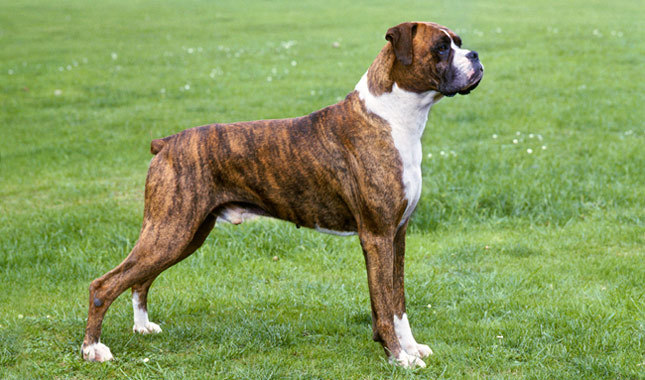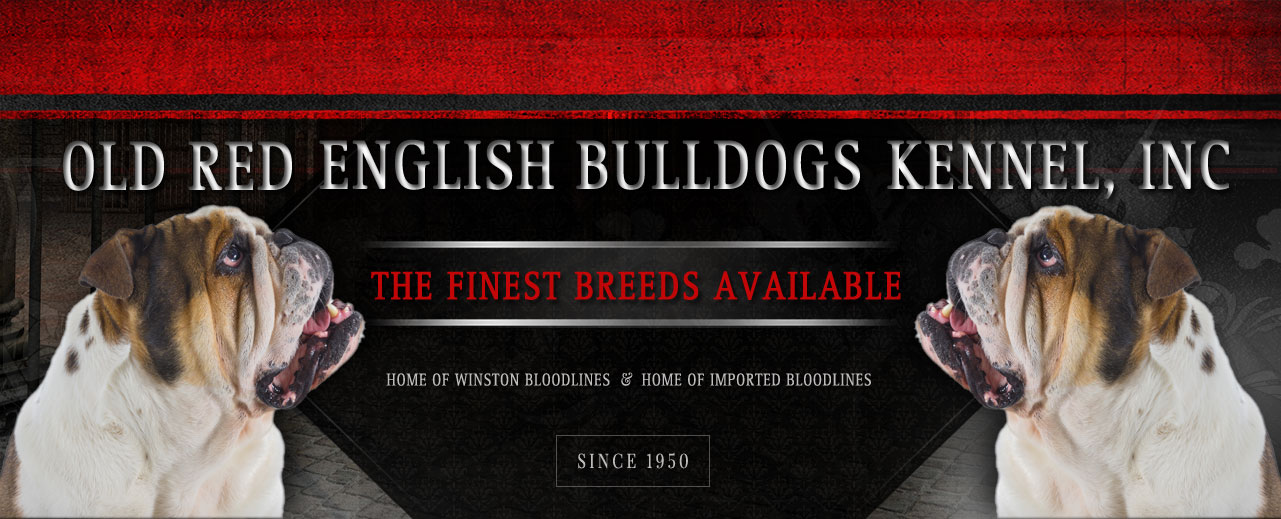
Country of Origin:
Germany
Size:
X-Large 55-90 lb
LifeSpan:
10 to 12 Years
Trainability:
Very Easy To Train
Energy Level:
High Energy
Grooming:
Brushing Once a Week or Less
Protective Ability:
Good Watchdog
Hypoallergenic Breed:
No
Space Requirements:
House with Yard
Compatibility With Other Pets:
May Be Okay With Other Pets If Raised Together
May Have Issues With Other Dogs
Not Recommended For Homes With Existing Dogs
Not Recommended For Homes With Small Animals
Litter Size:
6-9 Puppies
Names:
German Boxer, Deutscher Boxer
HEIGHT/WEIGHT
Males:
(AKC) 60-70 lbs, 22½-25 inches
Females:
(AKC) 55-65 lbs, 21½-23½ inches
Males:
(UKC) 60-70 lbs, at least 23 inches
Females:
(UKC) 55-65 lbs, 21½-23½ inches
KENNEL CLUBS AND RECOGNITION
American Kennel Club:
Working Group
ANKC (Australian National Kennel Council):
Group 6 (Utility)
CKC(Canadian Kennel Club):
Group 3 (Working Dogs)
FCI (Federation Cynologique Internationale):
Section 2.1 : Mastiffs
KC (The Kennel Club):
Working
NZKC (New Zealand Kennel Club):
Group 6 – Utility
UKC (United Kennel Club):
Guardian Dog
HISTORY:
Proper temperament is of paramount importance to Boxer breeders and standards, and most reputable breeders work hard to produce dogs with sound and stable temperaments. Unfortunately, commercial and inexperienced breeders have created dogs with unstable and often aggressive or fearful temperaments. As a result, anyone interested in acquiring a Boxer should carefully select a breeder or rescue group. Overall, Boxers are known for being loyal, affectionate, playful, inquisitive, and clownish.
A well-bred Boxer should be both a loving and affectionate family companion as well as a determined protector. Most Boxers are extremely affectionate with their families, many fawningly so. This can be a problem, as Boxers often come to believe they are lap dogs and will try to be on top of their favorite people at all times. This breed is also known to suffer from severe separation anxiety. Boxers are highly loyal and form very deep attachments to their families. Few Boxers are one-person dogs; they tend to become close with every family member. The primary area where Boxers exhibit a range of temperaments is in how they deal with new people. Boxer standards call for this breed to be distrustful and suspicious of strangers, and indeed, many Boxers are wary of new people. Boxers that have not been properly socialized may develop aggression issues. However, many modern Boxers are not suspicious of anyone and will eagerly greet and welcome any potential new friend.
Training is essential, as Boxers are very likely to jump up on people otherwise. While almost all Boxers are very alert and make excellent watchdogs, the breed’s ability as a guard dog depends largely on the individual dog. Some Boxers, especially those trained for protection, make excellent guard dogs, while others would lick an intruder to death before showing any aggression. With proper training and socialization, Boxers are generally well-regarded with children. They are known for being both playful and gentle with children and often form very close attachments to them. Boxers can become devoted guardians of their little friends. However, very young Boxers and very young children may not be the best housemates, as overly exuberant Boxer puppies may accidentally bowl over a child while playing.
One of the greatest areas of concern for Boxer owners is dog aggression, particularly same-sex aggression. Many Boxers are highly intolerant of members of the same sex, especially unspayed or unneutered ones, to the point where they actively seek to engage in combat with them. It is advisable to keep Boxers in a household with a canine member of the opposite sex, which is why many Boxer owners have one male and one female dog. Proper training and socialization can reduce potential difficulties, though they may not completely eliminate them. These issues are much more severe with unfamiliar dogs, but many Boxers will at least begrudgingly tolerate a member of the same sex with which they are familiar. In addition to same-sex aggression, it is not uncommon for Boxers to develop dominance, territorial, or possessiveness issues, as well as general dog aggression.
Boxers are a typical breed when it comes to non-canine pets. Boxers raised with the family cat will likely accept it as a member of the pack and give it few problems. Boxers that have not been socialized with other animals are more likely to pursue and potentially attack them. This breed has a relatively high prey drive (though not as high as breeds such as the Jack Russell Terrier or Redbone Coonhound), and owners must consistently work with their dogs from a young age to control it. Always remember that a Boxer is a powerful and athletic breed capable of seriously injuring or even killing a small animal with little effort.
Boxers are a very trainable breed. They have been used for tasks requiring intense training and great intelligence, such as seeing-eye and police work, and Boxers have regularly competed at the highest levels of obedience and agility competitions. Most (but certainly not all) Boxers are highly intelligent and capable of learning quickly. However, this breed presents a number of training challenges. Boxers are known for being very stubborn. This breed does not live to please and prefers to do its own thing. Sometimes a Boxer will refuse to perform a task, and that’s the end of it. This breed often has selectively poor listening skills or simply chooses not to obey. Many fanciers believe these difficulties can be resolved by changing from a correction-based training method to a rewards-based one. Boxers are somewhat headstrong and resistant to correction but are generally very eager for any reward. As a result, training regimens for Boxers should involve a heavy emphasis on positive reinforcement and treats.
As almost anyone who has encountered one of these dogs will attest, Boxers are very energetic and playful. The average Boxer is always ready to play and quite eager to do so. Boxer owners must make a dedicated effort to provide their dogs with sufficient vigorous exercise. Boxers need at least one hour of exercise every day, with the more intense the workout, the better. This breed needs a long, brisk walk at a minimum and preferably time to run around in a safely enclosed space. Boxers are not usually good jogging companions, as they tend to become winded quickly. It is imperative that Boxers have outlets for their energy; otherwise, they will develop health and behavioral issues. These dogs are likely to become hyperactive, excessively excitable, vocal, aggressive, and intensely destructive without proper exercise. Behavioral problems caused by a lack of exercise are the primary reason that many abandoned Boxers end up in animal shelters. Once Boxers get the exercise they need, most will calm down substantially indoors. However, a Boxer is never truly a calm dog. While they are accepting of a walk or a run, most Boxers prefer to get their exercise through play, games, or other activities that stimulate both their body and mind. Boxers love games like fetch and excel at competitions like agility. The Boxer’s activity level is very desirable to many families, especially those seeking an active dog who can accompany them on activities from hiking in the mountains to fishing on the ocean.
Potential owners need to be aware that the Boxer is not a breed for the fastidious or easily embarrassed. Boxers are very “doggy” dogs. Breed members like to roll in the mud, run through dirt, jump into piles of leaves, and then track it all into the house, sometimes laying on the sofa. Boxers also drool a great deal. Boxer owners must accept that these dogs will occasionally fling drool around in their excitement. Most Boxers are also messy eaters and drinkers, often leaving trails from their bowls to the living room. More disconcerting for most owners is the wide range of unusual sounds and emissions this breed makes. The shortened face of the Boxer means that these dogs snort, grunt, and wheeze, which can be disconcerting. The average Boxer snores loudly and frequently. The greatest problem is the breed’s flatulence; Boxers pass gas more frequently and with more potency than most other dogs of a similar size, which can be highly unpleasant for anyone in the room.
GROOMING REQUIREMENTS:
These are the Bulldogs and Mastiffs we breed and sell.
The pictures on each page are for identification purposes and OldBulldogs.com does not own every animal pictured. These pages are informational and intended to describe the standards of each breed.
- Alano Español
- Alapaha Blue Blood Bulldogs
- American Bandogge Mastiffs
- American Bully-Bullies
- American Pit Bull Terriers
- American Staffordshire Bullies
- American Staffordshire Terriers
- Arkansas Giant Bulldogs
- Australian Bandogge Mastiffs
- Australian Bulldogs
- American Bulldogs-Old Time Southern Bulldogs-Old Southern Whites
- Banter Bulldogs
- Boxer Bulldogs
- Bull Terriers
- Bull Mastiffs
- Miniature Bull Terriers
- Mexican Bulldogs
- Miniature English Bulldogs
- Neapolitan Mastiffs
- Old Boston Bulldogs
- Olde English Bulldogges
- Old Victorian Bulldogs
- Patterdale Terrier
- Perro de Presa Canario
- Performance-Standard Type American Bulldogs
- Perro de Presa Mallorquin
- Panja Mastiffs
- Renascence Bulldogs
- South African Boerboel
- Staffordshire Bull Terriers
- Saint Bernard
- Valley Bulldogs
- Winston Working Bulldogs
- Winston’s Working Mastiffs
- Winston’s Working Terriers
- Winston’s Working Hounds
- Winston’s Working Shepherds
